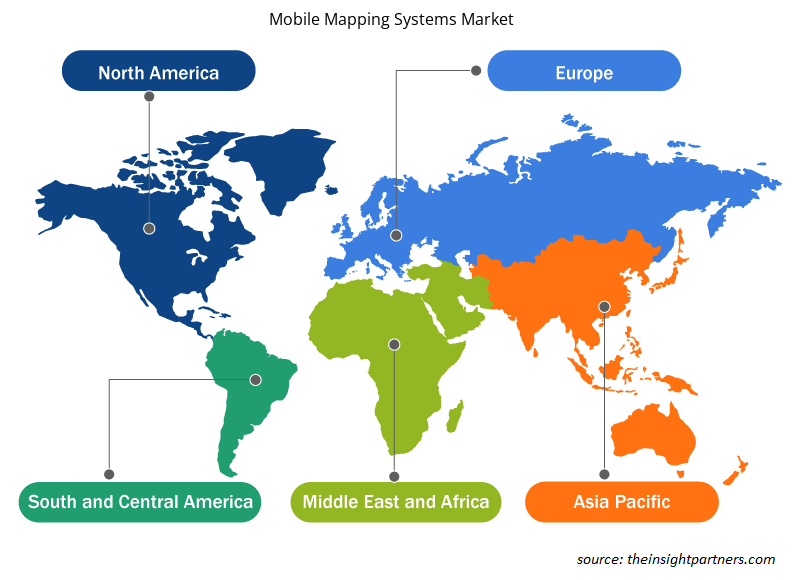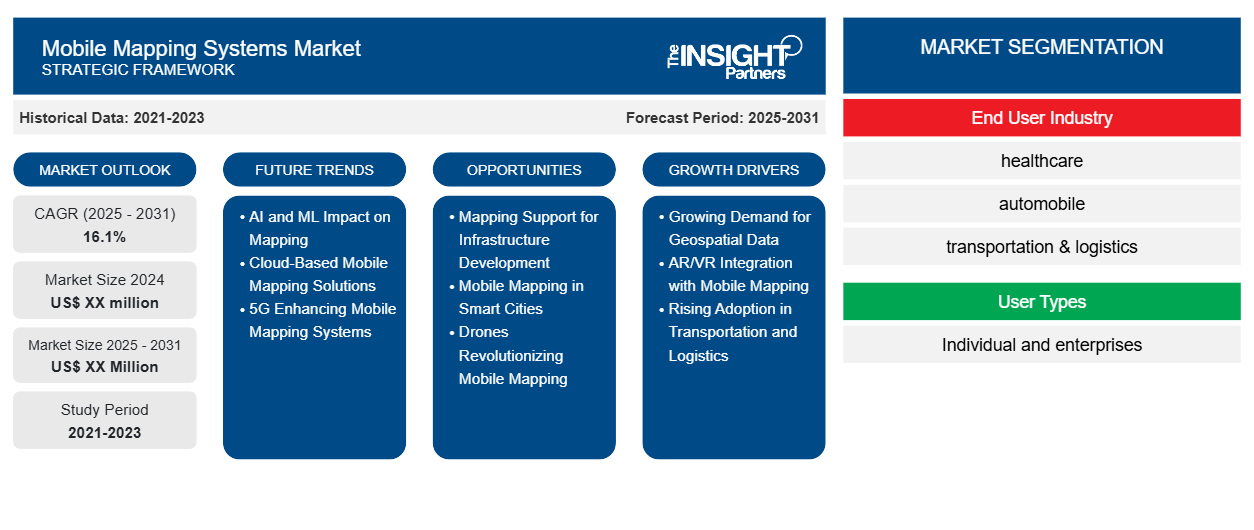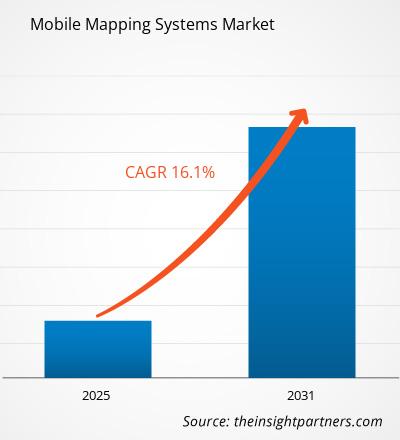Der Markt für mobile Kartierungssysteme wird voraussichtlich von 2024 bis 2031 eine durchschnittliche jährliche Wachstumsrate (CAGR) von 16,1 % verzeichnen, wobei die Marktgröße von XX Millionen US-Dollar im Jahr 2024 auf XX Millionen US-Dollar bis 2031 wachsen wird.
Der Marktbericht für mobile Kartierungssysteme ist nach Diensten, Endbenutzerbranche und Benutzertypen segmentiert. Die globale Analyse ist weiter auf regionaler Ebene und nach wichtigen Ländern aufgeschlüsselt. Der Bericht bietet den Wert in US-Dollar für die oben genannte Analyse und Segmente.
Zweck des Berichts
Der Bericht „Mobile Mapping Systems Market“ von The Insight Partners zielt darauf ab, die aktuelle Landschaft und das zukünftige Wachstum sowie die wichtigsten treibenden Faktoren, Herausforderungen und Chancen zu beschreiben. Dies wird verschiedenen Geschäftspartnern Einblicke geben, wie zum Beispiel:
- Technologieanbieter/-hersteller: Um die sich entwickelnde Marktdynamik zu verstehen und die potenziellen Wachstumschancen zu kennen, damit sie fundierte strategische Entscheidungen treffen können.
- Investoren: Durchführung einer umfassenden Trendanalyse hinsichtlich der Marktwachstumsrate, der finanziellen Marktprognosen und der Chancen entlang der Wertschöpfungskette.
- Regulierungsbehörden: Zur Regulierung von Richtlinien und Überwachungsaktivitäten auf dem Markt mit dem Ziel, Missbrauch zu minimieren, das Vertrauen der Anleger zu bewahren und die Integrität und Stabilität des Marktes aufrechtzuerhalten.
Marktsegmentierung für mobile Kartierungssysteme
Endverbraucherindustrie
- Gesundheitspflege
- Automobil
- Transport und Logistik
- Regierung und öffentlicher Sektor
- Video-Unterhaltung
- Immobilie
- Reise & Gastgewerbe und Bauwesen
Benutzertypen
- Privatpersonen und Unternehmen
Dienstleistungen
- Standortbasierte Dienste
- Standortbasierte Suche
- 3D-Mapping
- Abonnement und Support für Indoor-Mapping und Lizenzierung
Geographie
- Nordamerika
- Europa
- Asien-Pazifik
- Süd- und Mittelamerika
- Naher Osten und Afrika
Passen Sie diesen Bericht Ihren Anforderungen an
Sie erhalten kostenlos individuelle Anpassungen an jedem Bericht, einschließlich Teilen dieses Berichts oder einer Analyse auf Länderebene, eines Excel-Datenpakets sowie tolle Angebote und Rabatte für Start-ups und Universitäten.
- Holen Sie sich die wichtigsten Markttrends aus diesem Bericht.Dieses KOSTENLOSE Beispiel umfasst eine Datenanalyse von Markttrends bis hin zu Schätzungen und Prognosen.
Wachstumstreiber auf dem Markt für mobile Kartierungssysteme
- Wachsende Nachfrage nach Geodaten: Genaue Geodaten sind ein wichtiger Treiber auf dem Markt für mobile Kartierungssysteme. Branchen wie Stadtplanung, Transport, Landwirtschaft und Katastrophenmanagement sind auf Datenentscheidungen angewiesen; daher wächst die Nachfrage nach Geodaten rasant. Mobile Kartierungssysteme liefern hochaufgelöste Daten, die Echtzeitanalysen und standortbasierte Erkenntnisse ermöglichen.
- AR/VR-Integration mit Mobile Mapping: Die sich entwickelnde Technologie und das Potenzial der Kombination von AR/VR mit mobilen Mapping-Systemen bieten enorme Möglichkeiten, insbesondere für die Videospielbranche, den Tourismus und den Immobiliensektor. AR-Anwendungen überlagern die reale Ansicht physischer Umgebungen mit digitalen Informationen; hochpräzise Mapping-Daten ergänzen das oben genannte Erlebnis. Der Immobiliensektor nutzt VR für virtuelle Rundgänge durch Immobilien, die ein gutes 3D-Mapping erfordern.
- Steigende Akzeptanz in Transport und Logistik: Der Transport- und Logistiksektor nutzt zunehmend mobile Kartierungssysteme, um seine Abläufe zu optimieren und die Effizienz zu verbessern. Routenoptimierung, Anlagenverfolgung und Infrastrukturinspektion sind einige der wichtigsten Anwendungen, die diese Systeme in diesem Sektor spielen. Beispielsweise können mobile Kartierungssysteme detaillierte Karten für autonome Fahrzeuge erstellen, sodass diese sicher navigieren und Entscheidungen in Echtzeit treffen können. Logistikunternehmen nutzen die Systeme auch, um Lieferprozesse zu optimieren und Flottenbewegungen zu überwachen. Mit dem zunehmenden Fokus auf nachhaltigen Transport und intelligente Logistik werden mobile Kartierungssysteme zu einem unverzichtbaren Instrument zur Erreichung operativer Spitzenleistungen. Dieser Trend wird dem Markt voraussichtlich auch großes Wachstum bescheren, da der Bedarf an effizienten Transport- und Logistiklösungen weiter wächst.
Zukünftige Trends auf dem Markt für mobile Kartierungssysteme
- Auswirkungen von KI und ML auf das Mapping: KI und ML haben die mobile Mapping-Branche revolutioniert. Die Datenanalyse ist automatisiert und die gesammelten Informationen sind mit KI- und ML-Methoden im Vergleich zu herkömmlichen Methoden viel genauer. Ein KI-Algorithmus ist im Vergleich zu herkömmlichen Methoden bei der Verarbeitung großer Datensätze schneller und bietet so Einblicke in Muster sowie prädiktive Analysen, die sonst nie erreicht werden könnten.
- Cloudbasierte mobile Mapping-Lösungen: Cloudbasierte Mapping-Lösungen haben sich als das neue Gesicht der mobilen Mapping-Branche herauskristallisiert. Die Cloud-Technologie bietet skalierbare Speicher- und Verarbeitungsfunktionen: Die Speicherung und Analyse großer Mengen georäumlicher Daten ist jetzt direkt möglich, ohne dass eine Infrastruktur vor Ort entwickelt werden muss. Dieser Trend ermöglicht den Austausch von Informationen und die Zusammenarbeit in Echtzeit und ist für die Baubranche sehr nützlich, deren Stakeholder auf aktualisierte Karten zugreifen müssen. Die Integration der Cloud in mobiles Mapping senkt die Betriebskosten und macht Daten leichter zugänglich.
- 5G verbessert mobile Kartierungssysteme: In Verbindung mit 5G-Netzwerken ist mit einer deutlichen Umgestaltung der mobilen Kartierungsbranche zu rechnen. Mobile Kartierungssysteme könnten durch 5G Daten mit höherer Dichte verarbeiten, wie etwa hochauflösende Karten und Echtzeitinformationen, und so die Natur mehrerer georäumlich abhängiger Branchen verändern, die auf genaue und aktuelle geografische Informationen angewiesen sind.
Marktchancen für mobile Kartierungssysteme
- Unterstützung der Infrastrukturentwicklung durch Kartierung: Da viele Entwicklungsländer massiv in die Entwicklung der Infrastruktur investieren, beispielsweise in Straßen, Eisenbahnen und Stadtplanung, für die detaillierte Karten und Geodaten erforderlich sind, können mobile Kartierungssysteme Regierungen und Organisationen in diesen Regionen bei der effizienten Planung und angemessenen Verteilung von Ressourcen und beim Katastrophenmanagement unterstützen. Unternehmen, die sich mit diesen aufstrebenden Regionen befassen, können schnell einen riesigen, unerschlossenen Markt erobern und so neue Einnahmequellen erschließen.
- Mobiles Mapping in Smart Cities: Angesichts der rasanten Urbanisierung und des zunehmenden Einflusses von Smart Cities kann dieses Konzept nicht mehr ignoriert werden. Mobile Mapping-Systeme sind für den Aufbau einer Smart-City-Infrastruktur von entscheidender Bedeutung, da sie zuverlässige räumliche Echtzeitinformationen liefern, die bei der Verwaltung von Verkehrsnetzen, öffentlichen Versorgungseinrichtungen und Notdiensten helfen. Der Aufschwung bietet Anbietern von Mapping-Systemen die Möglichkeit, mit nationalen Regierungen und lokalen Behörden bei der Entwicklung ganzheitlicher Lösungen für Smart-City-Projekte zusammenzuarbeiten und so ein nachhaltiges Marktwachstum auf lange Sicht zu ermöglichen.
- Drohnen revolutionieren die mobile Kartierung: Drohnen revolutionieren die Perspektive der mobilen Kartierung und bieten neue Funktionen für die Datenerfassung, beispielsweise für abgelegene Landschaften, Baustellen und Katastrophengebiete. Angesichts der Weiterentwicklung der Drohnentechnologie und der sich ändernden Natur der Regulierungsrichtlinien werden Drohnen-basierte mobile Kartierungssysteme wahrscheinlich in einer großen Anzahl von Geschäftsvorhaben eingesetzt und bieten diesen Unternehmen damit neue Wachstumsmöglichkeiten.
Regionale Einblicke in den Markt für mobile Kartierungssysteme
Die regionalen Trends und Faktoren, die den Markt für mobile Kartierungssysteme im gesamten Prognosezeitraum beeinflussen, wurden von den Analysten von Insight Partners ausführlich erläutert. In diesem Abschnitt werden auch die Marktsegmente und die Geografie für mobile Kartierungssysteme in Nordamerika, Europa, im asiatisch-pazifischen Raum, im Nahen Osten und Afrika sowie in Süd- und Mittelamerika erörtert.

- Erhalten Sie regionale Daten zum Markt für mobile Kartierungssysteme
Umfang des Marktberichts zu mobilen Kartierungssystemen
| Berichtsattribut | Details |
|---|---|
| Marktgröße im Jahr 2024 | XX Millionen US-Dollar |
| Marktgröße bis 2031 | XX Millionen US-Dollar |
| Globale CAGR (2025 - 2031) | 16,1 % |
| Historische Daten | 2021-2023 |
| Prognosezeitraum | 2025–2031 |
| Abgedeckte Segmente | Nach Endbenutzerbranche
|
| Abgedeckte Regionen und Länder | Nordamerika
|
| Marktführer und wichtige Unternehmensprofile |
|
Dichte der Marktteilnehmer für mobile Kartierungssysteme: Auswirkungen auf die Geschäftsdynamik verstehen
Der Markt für mobile Kartierungssysteme wächst rasant, angetrieben durch die steigende Nachfrage der Endnutzer aufgrund von Faktoren wie sich entwickelnden Verbraucherpräferenzen, technologischen Fortschritten und einem größeren Bewusstsein für die Vorteile des Produkts. Mit steigender Nachfrage erweitern Unternehmen ihr Angebot, entwickeln Innovationen, um die Bedürfnisse der Verbraucher zu erfüllen, und nutzen neue Trends, was das Marktwachstum weiter ankurbelt.
Die Marktteilnehmerdichte bezieht sich auf die Verteilung der Firmen oder Unternehmen, die in einem bestimmten Markt oder einer bestimmten Branche tätig sind. Sie gibt an, wie viele Wettbewerber (Marktteilnehmer) in einem bestimmten Marktraum im Verhältnis zu seiner Größe oder seinem gesamten Marktwert präsent sind.
Die wichtigsten auf dem Markt für mobile Kartierungssysteme tätigen Unternehmen sind:
- Google, Inc
- Microsoft Corporation
- Apple, Inc.
- Foursquare Labs, Inc
- Ericsson
Haftungsausschluss : Die oben aufgeführten Unternehmen sind nicht in einer bestimmten Reihenfolge aufgeführt.

- Überblick über die wichtigsten Akteure auf dem Markt für mobile Kartierungssysteme
Wichtige Verkaufsargumente
- Umfassende Abdeckung: Der Bericht deckt die Analyse von Produkten, Diensten, Typen und Endbenutzern des Marktes für mobile Kartierungssysteme umfassend ab und bietet einen ganzheitlichen Überblick.
- Expertenanalyse: Der Bericht basiert auf dem umfassenden Verständnis von Branchenexperten und Analysten.
- Aktuelle Informationen: Der Bericht stellt durch die Abdeckung aktueller Informationen und Datentrends Geschäftsrelevanz sicher.
- Anpassungsoptionen: Dieser Bericht kann angepasst werden, um spezifische Kundenanforderungen zu erfüllen und die Geschäftsstrategien optimal anzupassen.
Der Forschungsbericht zum Markt für mobile Kartierungssysteme kann daher dabei helfen, die Branchensituation und Wachstumsaussichten zu entschlüsseln und zu verstehen. Obwohl es einige berechtigte Bedenken geben kann, überwiegen die allgemeinen Vorteile dieses Berichts tendenziell die Nachteile.
- Historische Analyse (2 Jahre), Basisjahr, Prognose (7 Jahre) mit CAGR
- PEST- und SWOT-Analyse
- Marktgröße Wert/Volumen – Global, Regional, Land
- Branche und Wettbewerbsumfeld
- Excel-Datensatz



Report Coverage
Revenue forecast, Company Analysis, Industry landscape, Growth factors, and Trends

Segment Covered
This text is related
to segments covered.

Regional Scope
North America, Europe, Asia Pacific, Middle East & Africa, South & Central America

Country Scope
This text is related
to country scope.
Häufig gestellte Fragen
Some of the customization options available based on request are additional 3-5 company profiles and country-specific analysis of 3-5 countries of your choice. Customizations are to be requested/discussed before making final order confirmation, as our team would review the same and check the feasibility.
The report can be delivered in PDF/PPT format; we can also share excel dataset based on the request.
Key companies in this market are: Google, Inc., Microsoft Corporation, Apple, Inc., Foursquare Labs, Inc., Ericsson, Tomtom NV, Trimble Navigation Ltd., Telecommunications System, Inc., Qualcomm Atheros, Inc., Mapquest, Inc.
The Mobile Mapping Systems Market is expected to register a CAGR of 16.1% from 2023-2031.
Key future trends in this market are - the integration of AI and ML for audience targeting and ad placement optimization through real-time data analysis, streamlining ad operations via AI-driven automation, and enhancing ecosystem efficiency and intelligence.
The primary driving factors of the market are - Accurate geospatial data, evolving technology, and the potential of combining AR/VR with mobile mapping systems.
Trends and growth analysis reports related to Technology, Media and Telecommunications : READ MORE..
- Google, Inc
- Microsoft Corporation
- Apple, Inc.
- Foursquare Labs, Inc
- Ericsson
- Tomtom NV
- Trimble Navigation Ltd.
- Telecommunications System, Inc.
- Qualcomm Atheros, Inc.
- Mapquest, Inc.
The Insight Partners performs research in 4 major stages: Data Collection & Secondary Research, Primary Research, Data Analysis and Data Triangulation & Final Review.
- Data Collection and Secondary Research:
As a market research and consulting firm operating from a decade, we have published and advised several client across the globe. First step for any study will start with an assessment of currently available data and insights from existing reports. Further, historical and current market information is collected from Investor Presentations, Annual Reports, SEC Filings, etc., and other information related to company’s performance and market positioning are gathered from Paid Databases (Factiva, Hoovers, and Reuters) and various other publications available in public domain.
Several associations trade associates, technical forums, institutes, societies and organization are accessed to gain technical as well as market related insights through their publications such as research papers, blogs and press releases related to the studies are referred to get cues about the market. Further, white papers, journals, magazines, and other news articles published in last 3 years are scrutinized and analyzed to understand the current market trends.
- Primary Research:
The primarily interview analysis comprise of data obtained from industry participants interview and answers to survey questions gathered by in-house primary team.
For primary research, interviews are conducted with industry experts/CEOs/Marketing Managers/VPs/Subject Matter Experts from both demand and supply side to get a 360-degree view of the market. The primary team conducts several interviews based on the complexity of the markets to understand the various market trends and dynamics which makes research more credible and precise.
A typical research interview fulfils the following functions:
- Provides first-hand information on the market size, market trends, growth trends, competitive landscape, and outlook
- Validates and strengthens in-house secondary research findings
- Develops the analysis team’s expertise and market understanding
Primary research involves email interactions and telephone interviews for each market, category, segment, and sub-segment across geographies. The participants who typically take part in such a process include, but are not limited to:
- Industry participants: VPs, business development managers, market intelligence managers and national sales managers
- Outside experts: Valuation experts, research analysts and key opinion leaders specializing in the electronics and semiconductor industry.
Below is the breakup of our primary respondents by company, designation, and region:

Once we receive the confirmation from primary research sources or primary respondents, we finalize the base year market estimation and forecast the data as per the macroeconomic and microeconomic factors assessed during data collection.
- Data Analysis:
Once data is validated through both secondary as well as primary respondents, we finalize the market estimations by hypothesis formulation and factor analysis at regional and country level.
- Macro-Economic Factor Analysis:
We analyse macroeconomic indicators such the gross domestic product (GDP), increase in the demand for goods and services across industries, technological advancement, regional economic growth, governmental policies, the influence of COVID-19, PEST analysis, and other aspects. This analysis aids in setting benchmarks for various nations/regions and approximating market splits. Additionally, the general trend of the aforementioned components aid in determining the market's development possibilities.
- Country Level Data:
Various factors that are especially aligned to the country are taken into account to determine the market size for a certain area and country, including the presence of vendors, such as headquarters and offices, the country's GDP, demand patterns, and industry growth. To comprehend the market dynamics for the nation, a number of growth variables, inhibitors, application areas, and current market trends are researched. The aforementioned elements aid in determining the country's overall market's growth potential.
- Company Profile:
The “Table of Contents” is formulated by listing and analyzing more than 25 - 30 companies operating in the market ecosystem across geographies. However, we profile only 10 companies as a standard practice in our syndicate reports. These 10 companies comprise leading, emerging, and regional players. Nonetheless, our analysis is not restricted to the 10 listed companies, we also analyze other companies present in the market to develop a holistic view and understand the prevailing trends. The “Company Profiles” section in the report covers key facts, business description, products & services, financial information, SWOT analysis, and key developments. The financial information presented is extracted from the annual reports and official documents of the publicly listed companies. Upon collecting the information for the sections of respective companies, we verify them via various primary sources and then compile the data in respective company profiles. The company level information helps us in deriving the base number as well as in forecasting the market size.
- Developing Base Number:
Aggregation of sales statistics (2020-2022) and macro-economic factor, and other secondary and primary research insights are utilized to arrive at base number and related market shares for 2022. The data gaps are identified in this step and relevant market data is analyzed, collected from paid primary interviews or databases. On finalizing the base year market size, forecasts are developed on the basis of macro-economic, industry and market growth factors and company level analysis.
- Data Triangulation and Final Review:
The market findings and base year market size calculations are validated from supply as well as demand side. Demand side validations are based on macro-economic factor analysis and benchmarks for respective regions and countries. In case of supply side validations, revenues of major companies are estimated (in case not available) based on industry benchmark, approximate number of employees, product portfolio, and primary interviews revenues are gathered. Further revenue from target product/service segment is assessed to avoid overshooting of market statistics. In case of heavy deviations between supply and demand side values, all thes steps are repeated to achieve synchronization.
We follow an iterative model, wherein we share our research findings with Subject Matter Experts (SME’s) and Key Opinion Leaders (KOLs) until consensus view of the market is not formulated – this model negates any drastic deviation in the opinions of experts. Only validated and universally acceptable research findings are quoted in our reports.
We have important check points that we use to validate our research findings – which we call – data triangulation, where we validate the information, we generate from secondary sources with primary interviews and then we re-validate with our internal data bases and Subject matter experts. This comprehensive model enables us to deliver high quality, reliable data in shortest possible time.


 Holen Sie sich ein kostenloses Muster für diesen Bericht
Holen Sie sich ein kostenloses Muster für diesen Bericht